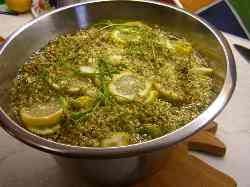 I have just tasted my elderflower cordial which is sitting in the fridge and it is almost done - look forward to drink it later! (When I get water, that is. We got a note last week about the water shutting down 8.00-16.00 today and tomorrow. There are also signs on the door and in both elevators. But do I remember to fill buckets and bottles before 8? Nope. Better luck tomorrow...)
I have just tasted my elderflower cordial which is sitting in the fridge and it is almost done - look forward to drink it later! (When I get water, that is. We got a note last week about the water shutting down 8.00-16.00 today and tomorrow. There are also signs on the door and in both elevators. But do I remember to fill buckets and bottles before 8? Nope. Better luck tomorrow...) Elderflower is my favourite cordial, versatile for much more than drinking it plain. I use it as a sweetener for ice tea and in desserts, for example. This is the first time I try to make it myself actually, but it is easy. I got the elderflower from some dancing friends with a big garden but tried in vain to get hold of organic lemons. You can make marmalade of the lemons afterwards but I don´t think I will use these even though I scrubbed them with hot water and detergent. Besides, my fridge is still full of jam from last summer and now the berry season is coming up again...
Elderflower cordial
Makes about 2000 ml, to mix with water
30-40 elderflower "clusters", make sure you use the right kind with flat clusters
3 large lemons, organic, or wash them really carefully with a hard brush and detergent
about 2000 grams caster sugar, I used about 1500 grams but then you have to freeze it to keep it for a longer time
2000 ml water
30 grams citric acid
(In my recipe you should also include two pinches of something called natriumbensoat, I have absolutely no idea what it is called in English... But I guess that the citric acid is enough conservation...)
Slice the lemon very thinly and layer them with the flowers in a large stainless bowl. Bring the water and sugar to the boil and dissolve the sugar. Then stir in the citric acid. Pour it over the flowers and lemons and let it sit in a cool place for 3-4 days. Drain off the cordial and pour it in small containers or plastic bags for the freezer, or if you use more sugar in clean bottles. Fill them to the brim, seal them and keep them in the fridge.
Making this cordial has made me nostalgic. Mum making cordial and jam is one of my strongest food memories from my childhood. Redcurrants and blackcurrants from the garden, picked from the many very old bushes we have there - a bucket or more. If she was going to make jam she picked the berries one by one, carefully. If it was cordial it wasn´t so fussy and we children could help out (sometimes at least).
Then she put everything in her largest casserole, added water and sugar and it boiled and boiled. I remember it boiled for hours but it cannot have been so long. It smelled so good and we stirred it with a large wooden spoon which was almost black from all the cordial cooking.
She went up to the attic and returned carrying a lot of bottles and jars in her apron. She washed them and put them in the oven. Everything was hot, we weren´t allowed to help in case we got burned. But we looked! She filled the jars with jam and put them on an old newspaper beside the stove to cool off. The cordial was poured into a big cloth sieve over a stainless bowl and dripped for hours. Then she poured it in bottles and the cordial was ready. We kept the jam and cordial in the potato cellar and went to get it one by one. The blackcurrant and redcurrant jam and cordial was for everyday use - what a luxury! I remember telling one of my friends off when se said she didn´t like mother´s cordial...


2 comments:
Natriumbensoat in German Natriumbenzoat and in English sodium benzoate (E 211)is a preservative. In this case citric acid is not used as a preservativ but to sour the liquid. Did you ever try elderflower sorbet made from elderflower cordial. Delicious!
The citric acid is necessary to make the sodium benzoate work. If the pH in the product is too high (=too little acid) the sodium benzoate will be of no use. That is why the lemons are there.
Post a Comment